Last Updated on March 2, 2022
One of the most exciting things about visiting another country is sampling the food. Our travels have introduced us to the vastness of Mexican street food and that’s what this article is about. Of course, authentic street tacos easily come to mind but we suggest many more foods to try during your visit. Look beyond taco carts and taste as many authentic street foods as possible during your travels in Mexico!
Table of Contents
Authentic Mexican Street Food: Variety and Value
Above all, the reality of Mexican street foods is a surprise with its amazing variety, wholesomeness and some odd combinations of junk food barely worth trying. We mention the latter simply to highlight popular street foods throughout the country, overly-processed or otherwise!
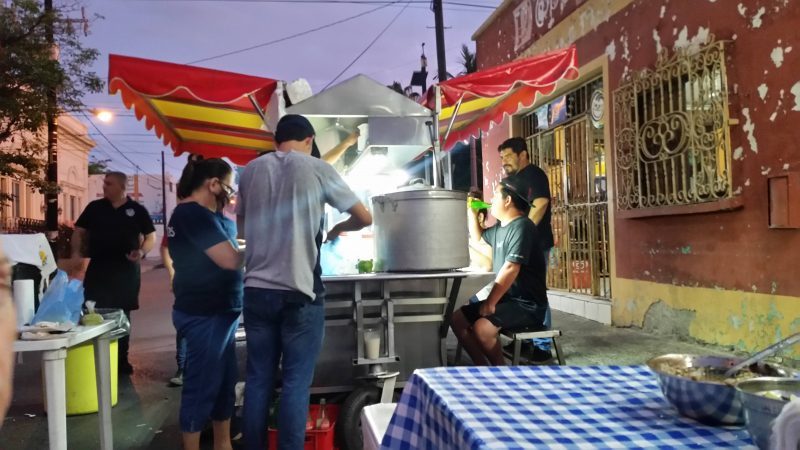
Disclosure: This article contains affiliate links to products and services whereby we receive a nominal commission if you make a purchase through one of these links. This comes at no extra cost to you. Please see our Disclaimer for full information.
Are You Ready to Discover More of Mexico?
- Take your adventure to the next level with our Baja beach camping guide.
- Don’t forget to try some fish tacos during your Baja journey.
- Your Baja adventure means knowing what to expect on the lonely Tranpeninsualr Highway; hang on tight and read our guide!
- You already know to avoid drinking the water but do really know what to expect when traveling to Mexico? We have it covered!
- Find your perfect accommodation option and check out these great Airbnb stays in Mexico.
- Have a look at these great deals available on Hotels.com and find a place that’s right for you and your budget.
We promise you’ll be amazed by the value of street food here, no matter what you order. Expect to fill yourself for the same price as a cup of fancy coffee back home. You’ll be surprised (and we’ll tell you) which dish represents the best overall value and its not street tacos. There’s much more to street food in Mexico so we include additional information at the end of the article.
A Brief Introduction to Street Food in Mexico
The word antojitos (little cravings/little whims) means snacks, or certain types of street foods. Don’t just think of snacks though – some street foods are more substantial than that. Also, many antojitos feature tortillas (mostly corn tortillas) and it’s difficult for foreign visitors to tell one antojito from another. It’s confusing at first and we’ll sort it out for you in this article.
Street foods, both widely-available and not, feature throughout this article. For example, papas locas and tlayudas (both below) aren’t easily found outside certain areas; we mention overall availability where applicable. Check back here frequently and look for updated versions of this street food guide as we continue traveling throughout Mexico. For now, let’s see what’s cooking!
Savory Street Food in Mexico
Discover enough hearty servings of meat, vegetables and soups to keep you full all day. Approach any Mexican street food vendor and simply ask what they’re serving; this is the first step to getting adventurous and trying new dishes. Look out for the following specialties and don’t miss out on the abundant selection of delicious street food in Mexico!
Birria
Travelers to Mexico looking for street food rarely think of soups and stews. However, be on the lookout for hearty birria at food stalls throughout the country. Birria features either goat or beef in a red tomato and chili-based broth. Excellent offerings include subtle hints of spices in the broth such as clove or allspice. Great birria also contains plenty of very tender, shredded meat.

Birria also comes served with minced onion and cilantro for garnishing plus lime wedges for squeezing juice into the mix. Believe it or not, this isn’t a spicy dish at all; you can always add salsa picante for heat if you wish. Expect a seemingly never-ending supply of hot corn tortillas to sop up the rich broth. This is authentic and, in our opinion, some of the best street food in Mexico.
Tamales
We love portable Mexican street snacks like soft, fresh tamales. These are lumps of masa (corn flour dough) formed around a variety of savory fillings like meat, seafood, vegetables, spices and cheese. Tamales come wrapped in either a corn husk or banana leaf and are steam- cooked. Vendors in Mexico sell these from carts as well as bikes, mopeds, motorcycles and even on foot.
Tamales are the perfect hand-held street treat; the masa firms up when cooked and the wrapper easily doubles as a plate. Few Mexican street foods require so little overhead to sell; many vendors serve tamales from just a steaming pot. Beware: it’s common in some parts of the country to put a whole olive in the tamale including the pit! Don’t chomp down too hard and break a tooth!
Vampiros
This cool-sounding street food is just another corn tortilla topped with meat, cheese and diced onions. Vampiros differ slightly in that the tortilla is cooked on a comal or lightly fried; this makes the edges of the tortilla curl up and resemble bat wings. We wonder if vampiros appeal much beyond a certain demographic of young kids or goths. Order one yourself and let us know!
See Our Chorreadas & Vampiros Video From Mazatlán!
In our experience, vampiros are found throughout Mexico. Considering how easy these are to make, any taco cart should offer them – the question is whether or not they’re listed with other tacos. These aren’t exactly breaking new ground but now you know what a vampiro is. Our late night neighborhood taco cart in Mazatlan (Hector’s – see photo above) oddly took a lot of phone-in orders for vampiros.
Chorreadas
These antojitos, only common in Sinaloa state, aren’t winning awards for originality. Here we have a ball of masa (corn dough) formed into a flat round base. This is brushed with fat and cooked on the griddle. This thick, cooked tortilla is topped with meat and cheese and finished over a grill. It sounds similar to other street foods because it is. This is an example of the sameness with antojitos in Mexico, no matter how regional they are.

These are served flat; perhaps that’s what makes them chorreadas? However, fold these bad boys over and you have a plain old taco. They’re good and filling but they aren’t breaking new ground in the Mexican street food scene. The only thing separating one example from another is the size; some taquerias cook massive chorreadas which are best shared between two people.
Pozole
This soup is commonly made with a red broth although green and white versions exist. Pozole includes every edible part of the pig, known as surtido in Mexico. If that’s more than you bargained for order it solo carne, or only meat. A main ingredient in this soup is hominy (lye-soaked corn kernels) which gives each variety of pozole a nutty flavor.
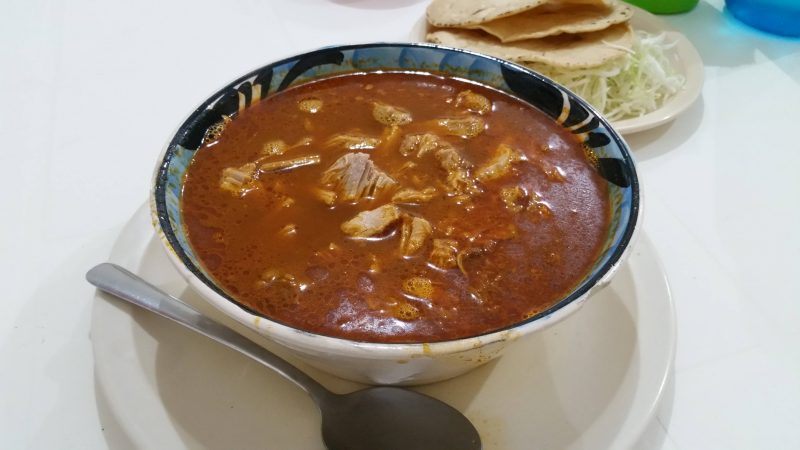
Garnish your serving of pozole with shredded cabbage, diced onion and cilantro. The green variety uses tart tomatillos and cilantro to flavor the broth. White pozole – not one of the most popular street foods in Mexico – gets the bulk of its flavor from hominy and a few varying spices. As always, bulk up your meal with plenty of warm corn tortillas, served complimentary with each order of soup.
Carne Asada
You won’t miss the giant plumes of smoke or the smell signalling a carne asada vendor; this is simply grilled beef served by the full or half kilo. An order of carne asada comes with a stack of corn tortillas and salsa, making for a very filling meal. Vendors use both skirt and flank steaks as well as thick cubes of lean beef on long skewers, like a kebab.
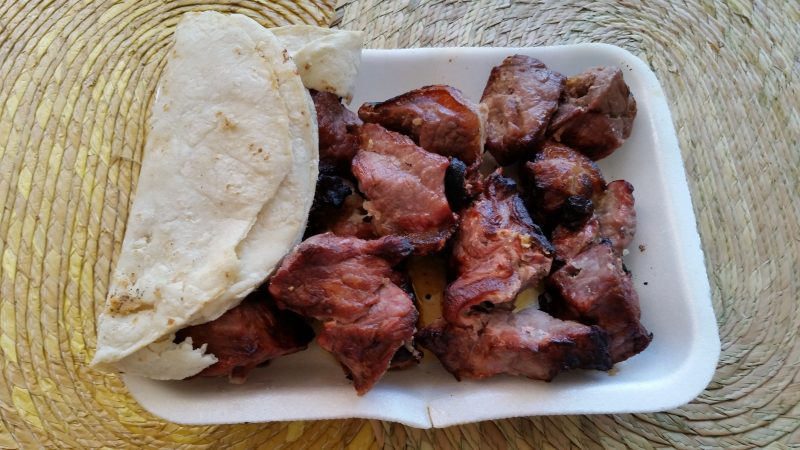
Often, the beef is marinated in various concoctions or just lightly seasoned prior to cooking. The very best tasting carne asada is grilled over coals instead of a gas flame, so look out for that. This is a real treat for us, both for the flavor and value; kilos go for 130 to 170 pesos but a half-kilo is enough for two people sharing. Mix up your street food choices in Mexico and try carne asada during your visit.
Carnitas
This is another of our favorite options and fortunately they’re available throughout the country. Carnitas are various cuts of pork meat and (occasionally) other edible bits slowly simmered in lard. Traditionally, this dish from Michoacán state gets cooked in large copper pots meant to distribute heat evenly. However, it’s how they cook carnitas that stands out: boiled in lard for extra rich flavor!
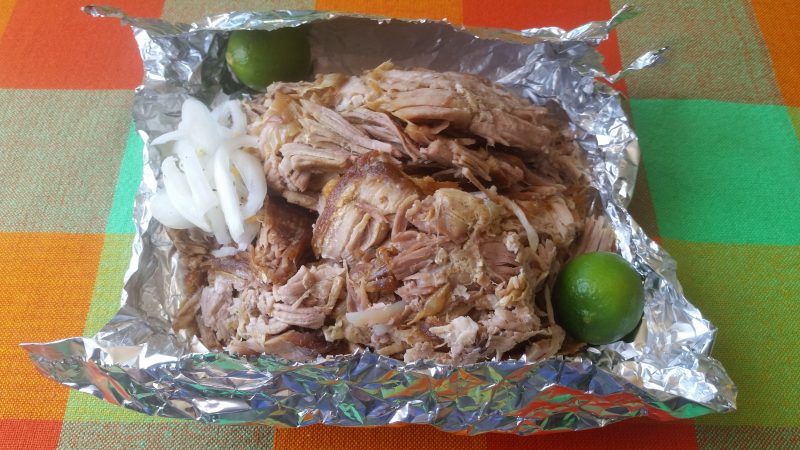
That slow process of boiling in lard produces an incredibly moist and tender pile of pork. Tortillas, salsas and assorted extra garnishes add a nice touch to the meal but carnitas stand up quite well on their own, too. Try them either way and see which you prefer. Similar to carne asada (above), order your carnitas by weight and with enough free tortillas and salsas to bust your belly.
Papas Locas
Sinaloa state is where you’ll find papas locas (crazy potatoes) served in the evening. Foil-wrapped spuds cooked slowly over charcoal come with a distinct smoky taste. The potatoes are then topped with plenty of butter, diced grilled beef, cheese, onion, cream and salsa. Many late night tacos carts and taquerias in Sinaloa serve these. We’ve also seen (and eaten!) papas locas in Loreto, Baja California Sur.
Considering the size of the potatoes used and the calorie-density of the toppings, it makes perfect sense to split this specialty. Although papas locas are good enough for a street food treat, they’d be even better with proper butter. Instead, each one we’ve had has been doused in what’s either margarine or real butter with artificial margarine flavor added! Consider yourself warned!
Huaraches
A huarache is a type of leather sandal common in Mexico. It’s also a type of street food found mostly around Mexico City and the state of Puebla. A corn dough base is topped with meat, beans, cheese, salsa, cilantro and then cooked on a griddle. Toppings vary but the edible version of a huarache won’t dazzle your taste buds so prepare to spice it up with plenty of salsa.
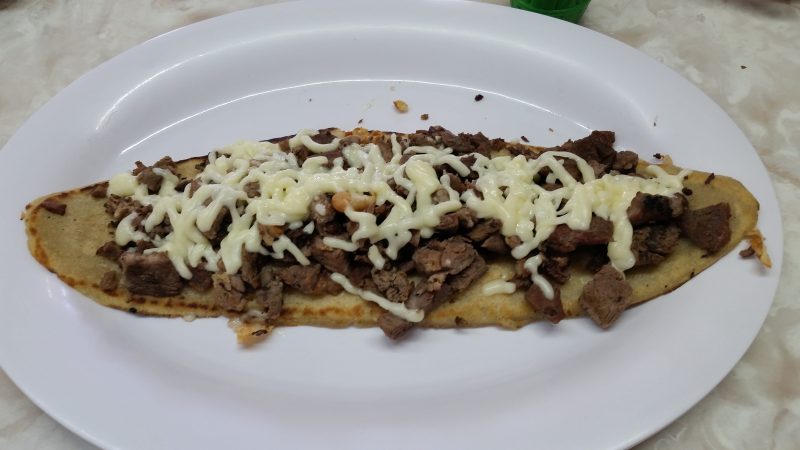
Still wondering why this street food mess is named after a piece of footwear? The shape of the corn dough base resembles the sole of a huarache sandal. Think of these as a sort of giant taco on a bigger, thicker corn tortilla. However, eat this heaping, hulking huarache with cutlery rather than by hand. Still, try one on for size when you see them cooking on the street in Mexico.
Tostilocos
Spoiler alert: we’ve never tried this and we hope you understand why! Tostilocos are extremely popular street snacks in Mexico, but a bag of artificially flavored nacho chips covered in chamoy sauce and gooey, glistening toppings doesn’t appeal to us. Nothing against a bit of artificial flavor, but these look and sound like a mess of grease, sodium, engineered components and other assorted chemicals.
Tostilocos are served right in the bag; the top is cut off and the complex array of components are literally dumped on. Epicureans hold the bottom half of the bag and use the provided plastic cutlery to scoop the mess up – or just use your fingers and hands! Still, tostilocos represent true street food in Mexico, no matter how phony the flavors are. Give ’em a try if you dare and tell us what you think.
Mulitas
What is a mulita? Don’t be shocked to learn these involve meat, cheese and tortillas! However, mulitas dazzle hungry folks with two tortillas sandwiching the meat/cheese fillings instead of one! If this was just one tortilla with assorted toppings we’d be talking about a handful of other antojitos, but here we have the added innovation of another tortilla – behold the mulita!!
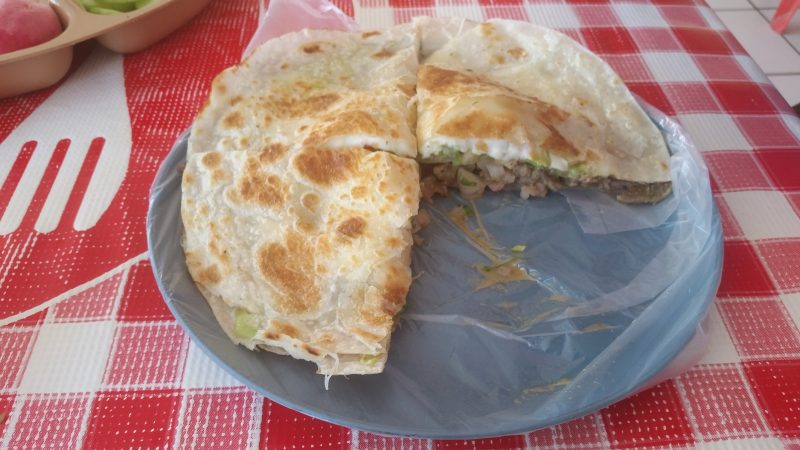
We sampled these on the Baja Peninsula, however we aren’t sure how widely-available they are throughout Mexico. Considering how easy these are to make – tortillas, meat, cheese, onion – these should be found in every city, town and village in the land. The mulita in the photo above was an absolutely delicious, belly-busting behemoth! Note the flour tortilla: availability of these diminish as you travel further south in Mexico.
Burros & Burritos
I must lump these two together; only size differentiates one from another. Burros are large flour tortillas wrapped around a variety of goodies. We’ve experienced two very distinct types of burros: tightly-wrapped and loosely bunched-up. The former resembles something similar to what we call burritos outside of Mexico while the latter is a giant mess which must be tackled with cutlery.
Burritos in Mexico are tiny flour tortillas tightly rolled around an assortment of fillings – similar to those north of the border but smaller. The first burritos I ever had in Mexico were pure, genuine street food bliss! I bought these through my driver-side window from a mobile vendor in Tijuana. He was selling burritos to vehicles lined up to cross into the U.S. How’s that for food from the streets of Mexico?
Durros
You’ll find this puffy wheat snack sold throughout the country. These are eaten plain or spiked with salsa, lime or chili powder. Durros and cold beer go together very well, no matter how you eat them! They’re good but they taste the same from one end of Mexico to another – that’s not a bad thing. We’ve even seen these sold in Southern California and New Mexico, both raw and cooked
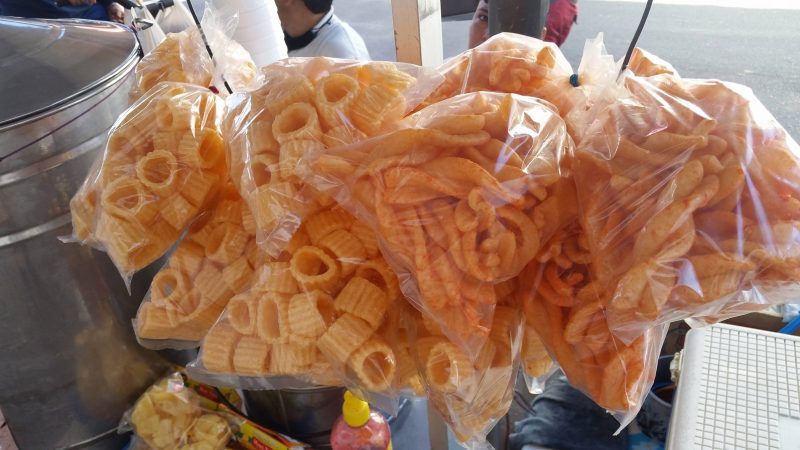
Raw durros resemble red uncooked pasta of varying shapes like small pinwheels, tubes and postage stamp-sized squares. These are sold in bulk and can be cooked at home. Frying these in oil bulks-up their size making them suitable for eating. Durros have a light flavor – not at all spicy or salty. Again, you’ll find these everywhere in the country so try some on your next visit to Mexico.
Gorditas
The corn-based theme surrounding much of Mexico’s famous street food continues with gorditas. These messy antojitos feature a thick round corn dough patty cooked on a griddle. This is then cut to form a “pocket” which is stuffed with – you guessed it – beans, meat, cheese and vegetables! These are filling, but much messier than they should be.
Those familiar with cuisine from El Salvador will notice a similarity between gorditas and the aforementioned country’s national dish – the pupusa. Both are cheap and filling, but that’s where our affinity for gorditas in Mexico ends. Interestingly, we’ve had gorditas not stuffed but made as flattened disks of dough briefly fried in oil. The finished product was a hollow, grapefruit-sized puffy snack with a sweet flavor.
Grilled or Roasted Chicken
A Video Featuring Our Favorite Grilled Chicken in Mazatlán!
Grilled chickens (pollo asado) and roasted chickens (rosti-pollo) are incredibly popular street foods in Mexico. They’re also a good value, costing about 150 pesos for a whole bird with salsa and unlimited corn tortillas. Look for anything grilled Estilo Sinaloanse (Sinaloan-style), cooked over charcoal which lends a unique flavor. Sinaloa-style grilled chicken taste better than rotisserie cooked offerings, however both are common.

Vendors sell full, half or even quarter-size chickens often with a few extras like french fries, macaroni salad or assorted vegetables (usually lettuce and tomatoes). We’ve eaten both grilled and roasted chicken in Mexico and never become tired of it! Follow the locals to the nearest vendor, see what’s cooking and order something truly authentic during your next visit. This is Mexico’s best value for street food!
Tortas
Like soups, sandwiches in Mexico likely aren’t on your list of street foods. Tortas are sandwiches which are hugely popular throughout the country and come in a very wide variety of combinations. These come on a particular type of white bread usually topped with meat, lettuce, cheese and mayo. Tortas are cheap, filling and very authentic.
A Torta Ahogada (drowned torta) is a popular variation offering a bit of spiciness to the mix. This messy sandwich, originally from Guadalajara, is doused in a chili-based sauce or a milder tomato sauce. These have become popular with street food vendors in Mexico so order one whenever you crave a bit of heat, no matter how sloppy they are!
Elotes, or Esquites
Corn is a big part of the street food culture in Mexico – where do all those tortillas come from? Either on the cob or served in a cup, you’ll find elotes, or esquites, at street stalls and from vendors on bikes as well. Street carts typically grill the corn (elotes) while mobile vendors often serve boiled or steamed ears. Either way, expect to have your elotes enhanced with mayo, cheese, lime juice and various spices like tajín.
Order your ear of corn impaled for hand-held eating or with the kernels cut into a cup; this latter method is perfect for eating your seasoned elotes without extra mess. Grilled cobs with attached husks have an extra smoky flavor to them. We lived in Mazatlan for months and had a regular elote vendor pass by our apartment on a motorcycle every evening!
Seafood
Depending on where you are in Mexico, street foods may include plenty of seafood, or mariscos. Don’t expect many fried dishes; hot climates on the coast are best suited for chilled selections from the ocean. Instead look for ceviches (fish/shellfish “cooked” in lime juice), cocteles (shellfish in tomato and clam juice) raw oysters, clams and scallops.
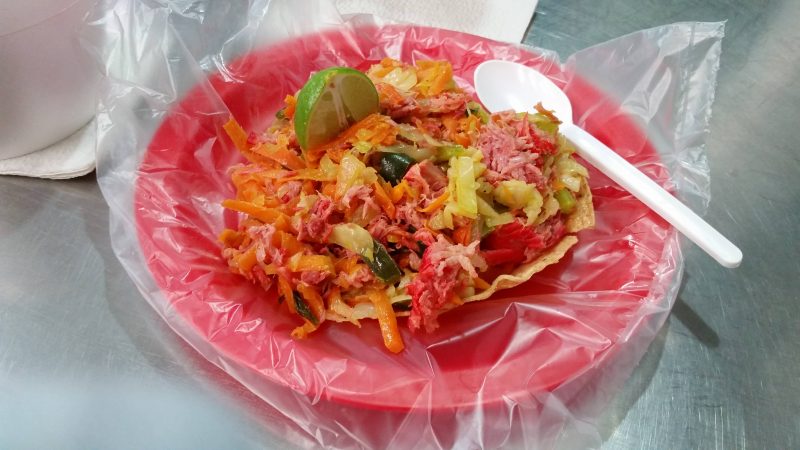
Seafood in Mexico is also quite cheap. On the coast you’ll pay a few dollars for a dozen oysters, shucked on the spot and served in lime juice and salsa picante. You’ll also find street stalls in Mexico serving seafood in whole coconuts with the top cut off or even in hollowed-out pineapples. Of course, always enjoy your cold seafood on top of a tostada with salsa and mayonnaise.
Tacos
Street tacos in Mexico likely top your list of what to try first during your visit. Nothing evokes a culinary experience here like a taco stall on the square or near a bustling market. All walks of life gather here for a quick bite while jostling for space at the counter and so should you. Follow the crowds, place your order and sample each of the salsas provided. Note: Flour tortillas become rare to extinct while going south in Mexico.

There are simply too many varieties to list; some street tacos include eyes, brains and more! Thankfully, beef and pork meat are the fillings of choice, so you’ll really need to search for the exotic varieties like tongue and tripe if you can handle it! Looking for crispy tacos in Mexico? They do exist here! These go by the name tacos dorados however not all tacos carts sell these.
Sweet Mexican Street Foods
All kinds of sweets from fruits, frozen treats, smoothies, pastries, doughnuts and candies await you on the streets of Mexico! After happily grazing on the savory options mentioned above, you’ll quickly find a dessert to satisfy any sweet craving. Locals absolutely love sweets and the sugary Mexican street food culture extends from natural goodies to plenty of gooey, artificially colored creations.
Fruits
Healthy, ripe fruit is readily available throughout all of Mexico and locals can’t eat enough of them. That means you’ll find plenty of street vendors selling peeled and diced cups of fruit, smoothies and fresh-squeezed juices. You’ll also find a good selection of natural(ish) treats made with crystallized candied limes, bananas, oranges, sheets of fruit paper and chili-spiked mango slices.

The presentation of certain fruits is just as important as the taste! For example many vendors carve, cut and arrange mangoes to resemble flowers! Chunky mixed fruits served in clear cups boast all sorts of attractive bright colors. The visual feasts on display pull you in and the sticky-sweet smell of ripe fruits seal the deal for you! Especially look out for exotic fruits like nanche (above).
Ice Cream and Bolis
From stationary street stalls to mobile coolers on wheels, ice cream in Mexico is easy to find. Get your ice cream on a cone, in a cup, on a stick or sometimes sold in long plastic bags called bolis. The latter example ranges from artificially colored and flavored options to pureed fruits mixed with milk and cream. Bolis are very popular in and around Mazatlan; plum (ciruela) flavor was my go-to favorite.
Ice Cream vendors will be found around the main square of cities and towns. Our favorite frozen treat stall in Mazatlan was in front of a bank nowhere near the square, so you never know where you’ll find one. If you don’t find any sold by street vendors in Mexico you will find plenty of ice cream shops selling an incredible selection of flavors and varieties.
Raspados
Look for this cold sweet treat throughout all of Mexico. Raspados (scrapings) are bits of shaved ice drizzled in your choice of sugary, fruity syrups. These are scraped from a giant block of ice into a cup, then flavored to suit your desire. These are similar to snow cones but are much easier to eat. Raspados also melt a lot quicker so use the provided spoon and dig in!

The raspado vendor uses a special tool to scrape a large block of ice. This tool collects the shavings which are emptied into a cup. The flavor of your choice is then added to the shaved ice. Some vendors include real fruit pieces in the syrups. Raspados are found throughout Mexico sold from street stalls, from push-carts on beaches and mobile vendors on sidewalks and town squares.
Churros
My school cafeteria (in Pennsylvania!) served these; the taste and appearance of Mexican churros are no different from what I remember! Of course, the cafeteria version wasn’t made on the street in Mexico. Genuine churros are sweet to eat and to watch while being made. Long ropes of dough are extruded through a star-shaped die, directly into a vat of hot oil. This fried treat is then dusted with sugar and cinnamon.
The extrusion process gives churros a characteristic shape; these grooves help the finished product hold onto the sugar/cinnamon coating. These are served in a bag, perfect for a sweet fix on the go. Churros also go good with a cup of coffee. These are found throughout the country and you’ll likely smell them being made before seeing them. Grab this fried street treat during your next visit to Mexico.
Other Sweet Treats
How about some sweet fish? Not the popular Swedish Fish candies but dried minnows known in Mexico as charales pescaditos. After that try some candied grasshoppers, or chapulines, coated in a sticky mix of sweet/salty red chili and tamarind. They come served with a wedge of fresh lime to complete the unique flavor experience.

We’ve only tried the candied grasshoppers once and haven’t sought them out for a snack since. These aren’t wild-caught because each vendor has thousands of crispy dried, farmed grasshoppers for sale! The fish are both wild-caught and farmed as well. Vendors sell charales pescaditos the same way: dried and spiked with a colorful coating of mildly spicy sweet stuff.
Bulk Candies
Sometimes you just want to buy gummy bears while walking down the street – right? Mexico leaves visitors feeling like a kid in candy store, for more reasons than the street food. I can argue whether candy should be included along with street food, but I won’t. Either way, plenty of candies await in Mexico when your sweet tooth decides to act up.
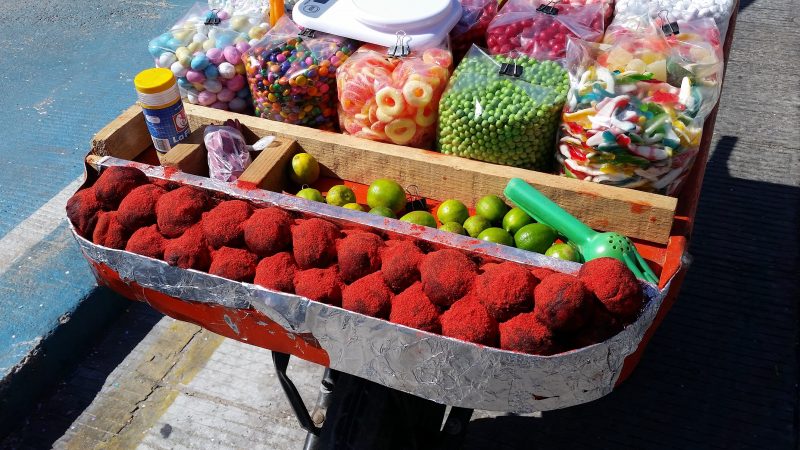
You’ll find familiar treats like soft assorted sugar-coated shapes, chewy stuff, hard candy, popcorn balls and lollipops. Look out for the unfamiliar goodies like cocadas (shredded, candied coconut), obleas con cajeta (caramel sandwiched between wafers), and ate de fruta (long strips of dried fruit leather or paper). Mexican street food or not, the assortment of dulces available will impress you!
Donas
Everybody loves donas (doughnuts) in Mexico and you’ll find them throughout the country. Trays of these are either set up on sidewalks or carried through the streets by vendors. These peddlers often have the goods covered in a clear plastic sheet to keep the flies away. If the flies do gather you’ll see the vendor shooing them away with improvised fly swatters.
Have You Tried Sweet Gorditas in Mexico?
Doughnuts in the U.S, have seen a bit of revival lately with all sorts of gourmet varieties and inventive flavor combinations. Donas in Mexico aren’t quite that trendy; expect a few varieties of old standbys like cream filled, plain or sugared. Still, these are quite tasty and difficult to resist once you see them. We’ve seen donas vendors walk into restaurants selling their wares so you’ll hardly miss a chance to try one during your visit.
Mexico Street Foods To Go
If you can’t find street food, it’ll find you instead! Many food vendors in Mexico get around on two or three-wheeled cycles outfitted for selling grub on the go. You’ll find mobile vendors cruising down neighborhood streets, cycling through parks and town squares or selling in parking lots. We’ve seen ice cream, seafood, prepared fruits and vegetables and even baked goods sold this way, adding yet another angle to Mexican street food.
Where and When to Find Street Food in Mexico
Simply put, street food is quite easy to find everywhere in Mexico. By far the largest concentrations are around the town/city’s public market, square(s), attractions and bus station(s). Most street food vendors in Mexico operate from early/mid-morning to afternoon. It’s common for many taco carts to only get going in the evening; our neighborhood taco stand around the corner in Mazatlan opened at 6:00 pm
Larger cities are full of neighborhoods with their own vendors and it seems like almost each street has at least someone passing through the neighborhood offering something to eat. As a rule of thumb, the vast majority of food vendors serve during daylight hours so don’t venture out too late if you expect a lot of choices.
How to Find the Best Street Food While Visiting Mexico
Every local has their own idea of the best so it’s a wise decision to follow them. A busy street food cart is a great indicator of excellent food and fresh, quality ingredients. Don’t expect the hip food truck scene found at home – Mexico has no need to embrace what many consider a cool retro thing north of the border.
Do expect just what the name implies: street food! You’ll find many carts set up directly on the street, sharing the roadway with vehicular traffic. If you’re familiar with the food truck scene in the U.S. you might be surprised by how simple street food is in Mexico. This includes many carts that may seem down-at-heel. Again, the locals know where the best treats are, even if it’s not a cool vintage truck.
In Conclusion…
Sure, Mexico’s famous street food scene is something you’ll want to sample for yourself. Some of it gets boring after a while, especially the foods made with corn dough, or masa. However, the street foods here are tasty, cheap and very filling. Your job is seek them out and our job is to keep updating this article with more of the street foods we discover during our travels in Mexico.
Pin Me Now!
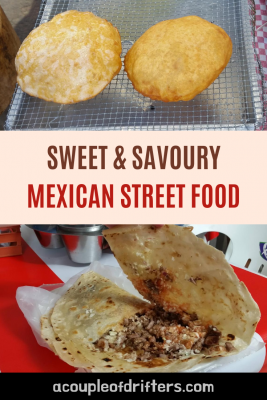

Great information. I can’t wait to try some of the recommendations.
Trish,
We hope you get to try them all soon!
Your Drifters,
Jerry and Fiona
Hello just a little (or not) correction.. We never have called them “duros” they are botanas and those specific ones are chicharrones de harina (we don’t care about the shape we call al of them chicharrones and de harina because of the material they are done) be careful because if you are on the street calling anything duros you are going to be albureado for sure!.. Do you know what an albur is? I hope you do.. Otherwise, be very careful with what you say specially on the street..
By the way I’d add chilaquiles and so, the famous tortas de chilaquiles..
Monica,
Indeed, we’ve heard this snack called a variety of different names, including the name you mention. However, we’ve heard them referred to as durros and duritos on many occasions, most often by the vendors selling them. Could these be regional names used in favor of another?
You mention duro as a word I shouldn’t use on the street, however we’ve seen these snacks referred to as durros, spelled differently. Am I missing something here?
As for the word albureado, what it means and being called that word: I assure you I don’t concern myself with being slighted by a name; I have yet to meet a Mexican that would call me albureado to my face anyway – and so what if they did? Further, they may say this behind my back and that’s just fine with me, too.
Thanks for the comment, Monica!
Your Drifters,
Jerry and Fiona